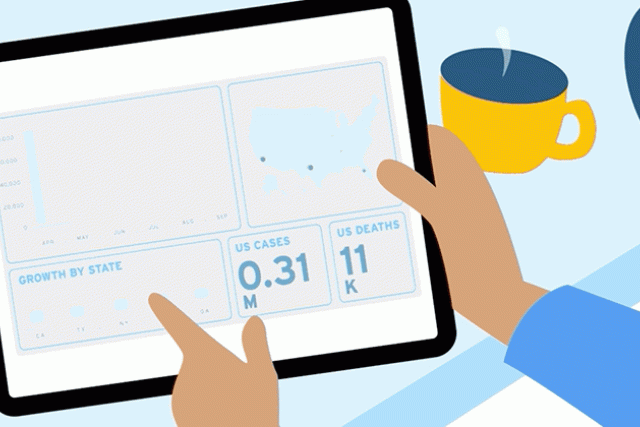Since the first person in the United States tested positive for COVID-19, public health officials have been compiling data to better understand SARS-CoV-2, the virus that causes COVID-19, and to track the disease’s spread.
“Data is so important because it helps health professionals, government officials and citizens understand the trajectory and course of the COVID-19 pandemic,” says Michael Pfeffer, MD, assistant vice chancellor and chief information officer at UCLA Health. “Without data, you don’t know if you have the appropriate resources available or if you need to make policy changes based on whether cases are increasing or decreasing. It really helps decision making on so many levels.”
But with updated figures being released daily, it can be difficult to make sense of this data and understand what the numbers mean on a practical level.
Dr. Pfeffer, who is also an associate clinical professor of medicine at the David Geffen School of Medicine at UCLA, and Annabelle de St. Maurice, MD, MPH, an assistant professor of pediatrics in the Division of Infectious Diseases at UCLA, cleared up some of the mystery:
Key data points and trends
There are several data points that epidemiologists, public health officials and infectious diseases physicians pay particular attention to, says Dr. de St. Maurice:
- Number of total diagnostic tests given per day
- Number of positive diagnostic tests per day
- Percent positivity (the percent of positive diagnostic tests out of total tests)
- COVID-19 related hospitalizations
- Intensive Care Unit (ICU) admissions
- Fatalities
This data is compiled on a local level and then rolled into statewide, national and global figures. Tracking this data allows scientists to see trends over time.
Why the percent positive rate matters
Percentage of positive tests is one way to determine whether states or communities are doing enough testing, Dr. Pfeffer says.
“In the beginning of the COVID-19 pandemic, we were really only testing symptomatic patients, so the percentage of positive tests was higher,” he says. “But as testing expanded to more people, including asymptomatic people who believed they’d been exposed, people coming into the hospital for a surgery or procedure, and others who work as first responders or health care workers and were being tested for screening purposes, your percent of positive tests is going to be significantly less.”
When the percent positive rate started creeping up again in California and other areas of the U.S. in July, it showed, in part, that diagnostic tests were once again only being given to the people who were most sick, implying that testing capability was down.
“If your percent positive rate is greater than 10% or 15%, you’re probably not testing enough people,” says Dr. de St. Maurice.
“On the other hand, if you’re over-testing,” she continues, “you’d expect your percent positivity to be quite low.”
One thing that’s important to note, she says: A percent positive rate for a community, such as L.A. County, is not equivalent to the percent of people in that region with an active COVID-19 infection.
“Percent positivity is the percent of people who were motivated enough to get tested – whether that’s because they were exposed, have symptoms or have risk factors – who were positive,” Dr. de St. Maurice says. “We don’t know the general number of people in Los Angeles who have COVID-19, although the CDC estimates that it’s typically 10 times the number of people who test positive.”
Look at the 7-day trend
When observing new cases, Dr. de St. Maurice recommends reviewing the seven-day trend rather than daily totals, and then comparing the past seven days to the seven previous.
“On weekends or holidays, there might be a lag in reporting, followed by a sharp increase in cases on Monday,” she says. “A seven-day trend gives you a better snapshot of what’s going on.”
Deaths, too, are best viewed as a seven-day trend, in part because some are not reported on the day they take place, but rather one or two days later.
How data can show if public health interventions are working
“It’s important for people to realize that interventions that we make today to try and reduce the spread of COVID-19 will take some time to have an impact on the number of cases,” Dr. de St. Maurice says. “Recognizing this lag rather than reacting to the daily numbers is really important.”
To illustrate this point, Dr. de St. Maurice says it takes, on average, about five days for someone exposed to SARS-CoV-2 to start showing symptoms. However, the virus’ incubation period can be up to 14 days.
Then, most people who are hospitalized, or die, due to COVID-19 have a more severe illness in their second week of infection. That means they may not be hospitalized for at least 21 days after exposure to the virus.
“When we’re thinking about the impact of interventions, such as universal mask wearing and stay-at-home orders, it’s important to realize that the effects of those orders may not be seen for a few days, and for up to a few weeks,” she says.
What about rate of transmission?
The viral rate of transmission is a measure of how contagious a disease is, Dr. de St. Maurice says. While it’s typically considered a set property of a virus, bacteria or pathogen, transmission rate also is affected by environmental measures being taken, she says, so a virus’ reproductive capability can be driven down.
“If one person is infected with COVID-19 and that one person isolates at home for 14 days or until they no longer have symptoms,” she says, “the virus can’t be spread to anyone else.”
In that case, the rate of transmission would be 0.0.
When a local rate of transmission is listed as 1.2, for instance, that’s an indication that each person who is positive for COVID-19 infects 1.2 more people. However, Dr. de St. Maurice says, “while it’s helpful to know if cases are growing in an area, it’s difficult to actually calculate this number.”
The only thing the general public really needs to know related to this figure, she continues, is that all of the public health measures being promoted – such as mask wearing and stay-at-home orders – have a real impact on viral transmission. “These measures are in place to really drive that reproductive number down.”
About the UCLA Health dashboard
As soon as COVID-19 became a local concern in Los Angeles, UCLA Health launched a COVID-19 dashboard, updated daily, on its website.
The UCLA Health dashboard shows:
- Total number of diagnostic tests
- Total number of positive diagnostic tests
- Number of currently hospitalized patients (at Ronald Reagan UCLA Medical Center and UCLA Health - Santa Monica Medical Center)
“The UCLA Health COVID-19 dashboard is a very simple way to visualize our testing data, and the key reason we share this information with the public is for transparency,” Dr. Pfeffer says. “We wanted to show our patients and staff how we are caring for our community when it comes to COVID-19. We are showing how many people we’ve tested and what those results have been, without sharing any identifying information.”
You can see that since the beginning of March, UCLA Health has been able to ramp up the number of tests being given each day, he says, which is a “real testament to everyone in the lab and all of the accompanying services.”
If you look at the total number of tests with positive results, you can see the percent positive rate is just about 4%. However, he adds, that percent should not be considered an indication of what’s happening in Los Angeles. “This represents UCLA Health patients and UCLA employees who are being tested in areas of Los Angeles where UCLA Health clinics and hospitals offer testing.”
Trusted local and national data sources
To really understand what’s happening on a local or statewide level, you need to look at data on the LA County Department of Public Health or the California Department of Public Health dashboards. The CDC dashboard is a good source of information for the country. Every hospital, including UCLA Health, rolls its data up to these larger government sources.
All of these dashboards include a daily update on the total number of cases and total number of deaths, as well as graphs that show whether daily cases are trending up or down.
Listen to the experts
Data doesn’t mean much — and can easily be misinterpreted — without being explained and put into context by experts, Drs. Pfeffer and de St. Maurice say.
An example of how data can easily be misread, Dr. de St. Maurice says, is when a friend reached out to her to say, “‘Oh my gosh, there’s a huge spike in the number of cases – we’re surging.’” But when she had her friend send her the graph she was looking at, she realized it indicated the cumulative number of cases, not the daily cases. And cumulative cases will always go up.
It’s best, Dr. de St. Maurice says, to listen to what trained epidemiologists, physicians and public health officials are saying about the data.
Dr. Pfeffer agrees. “It is important to not believe everything one hears about the data, and instead make sure to look to reputable sources to better help interpret it.”
Why increased testing does not mean more COVID-19 cases
A great example of data misinterpretation, Dr. Pfeffer says, is the often repeated idea that the reason there are more people with COVID-19 is because we’re doing more testing. “This is patently false,” Dr. Pfeffer says, “but it is a common statistical faux pas, and it can be confusing.”
He explained it this way: “If we stop testing for influenza, then the number of people with confirmed influenza would drop to zero. But there are still a lot of people out there with influenza – we just wouldn’t know it.”
“Now, when we apply that logic to COVID-19,” he continues, “if we increase the number of tests being given, yes, there will be more positive results. But those people had COVID-19 either way, with or without the test. We are just identifying more of them. With more testing, we will find more cases, but they were there in the first place.”
What is the trend looking like in L.A.?
When you take a step back from the daily numbers and even the seven-day averages, you can see how public health interventions impacted the data trends in Los Angeles.
“Cases definitely went down with the stay-at-home order,” Dr. de St. Maurice says, “and we saw a decrease in the percent positivity rate.” In June, she notes, there were days when the county’s percent positivity rate was closer to 5%, whereas in July and into August, the percent positive rate hovered above 8%, before starting to come back down.
“This data shows us that the number of cases in Los Angeles is still not where we want them to be,” she says.
Why public health interventions are so important
Dr. Pfeffer notes that while the public health message early on was that cloth face coverings and masks prevented people from spreading large droplets, thereby keeping others safe, “more and more reliable data shows that masks not only prevent transmission, but also protect the wearer.”
“When people were allowed to be in situations when you can’t wear a mask, such as eating indoors or going to a bar,” he continues, “the numbers went up.”
The main message being: Wear your mask!
Dr. de St. Maurice touted other interventions as well. “Stay at home. Maintain physical distance. Follow best practices for hand hygiene. And if you have any signs and symptoms of illness,” she says, “contact your primary care doctor and see if you meet criteria for testing.”
A final note about contact tracing
Contact tracing is the process by which, after a person receives a positive COVID-19 result, someone will reach out to everyone they’ve recently been in contact with to let them know they’ve likely been exposed to the virus.
Contact tracing efforts are gaining momentum in L.A. County, Dr. de St. Maurice says, but there have been challenges reaching people.
“If you get a call from L.A. County, you really should answer the phone and respond,” she says. “And if you have been exposed, you need to self-isolate and follow the L.A. County public health orders.”




